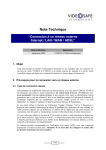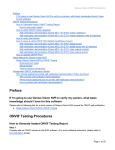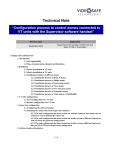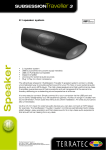Download Supervisor and Fritz! modem
Transcript
Technical Note “External network connection Internet / LAN / WAN / ADSL” Revision Date Application December 2006 VT200-N, VT100-N and Supervisor 1. Objective This Technical Note provides the necessary information to open an external network channel between the video servers VT200-N and VT100-N and the Supervisor. 2. External network connection requirements 2.1 Type of network connection To be able to connect the Supervisor to any VT200 or VT100 unit through an external network, it is necessary to connect them to a LAN (Ethernet 100/10BaseT) with permanent access to the external network, and a permanent network identifier for each one of them, either using a fixed global IP address or through a unique name and the dynamic IP address management supported by the units (refer to chapter 5 “dynamic IP address management”) In addition, to use the VAV functionality via external network, the Supervisor needs a permanent connection to Internet and permanent public IP address. Only in this way will the units be able to call to the Supervisor when an alarm is triggered. Thus, the units behave as if they were connected to the same LAN. If you are not going to use the VAV functionality or the VAV´s are going to be transmitted by another channel (PSTN, ISDN) the Supervisor can access the network by using any other channel (LAN, ADSL, remote telephone access) and be connected permanently or not to the network. The best option that we recommend to you is to use an ADSL router, with permanent connection and flat rate. Attention! It will be necessary to configure the router to work in this way. 1/10 2.2 Required bandwidth The main communication flow for video servers goes to the external network (upload). This is a disadvantage since the external network connection uses to be non-symmetrical and the upload bandwidth is lower than the download one. The main communication flow for the Supervisor goes to the PC (download), which is always more favorable. The download bandwidth in the Supervisor only needs to be equal to the upload bandwidth of the video servers. Take into account that the transmission bandwidth determines the number of images per second transmitted (image size: 5KB on average, 10KB if high quality in the VT200 is selected). 2.3 Configuring the Router Please, take into account that the configuration of the router must be carried out by the Internet provider in most cases. ADSL connections usually allow a PC or a LAN to access to the external network as users, but not as contents servers. For this utility you need to have the router configured. Therefore, before contracting this service, make sure that you will be able to configure the router to give access to the video servers using the public IP address. Configuration to give service to a VT100 or a VT200: It is necessary to map the port 9603 to the video server local IP address, for this is the listen port where it expects connections from the Supervisor. The protocol is TCP. Configuration to give service to a Supervisor: This configuration is necessary only if you are going to use the VAV functionality of the remote units by external network. It is necessary to map the port 9604 (for connections from the video servers) to the Supervisor local IP address. The protocol is TCP. 2.4 Security of communication Security is an important issue due to the use of public communication networks. The security of communication in our application is based on the following items: • It is necessary to know the IP address of the unit. • It is necessary to know the name and password of the unit. This information is always transmitted encrypted so it will not be possible to be deciphered by a third party. • The video files are transmitted in proprietary format and the transmission is carried out by non-standard methods. • There are no other accesses to the unit. Nevertheless, it is possible to complete the security using common methods of TCP/IP network administration. Our system only requires to open the port 9603 in the video servers to communicate with the Supervisor, and the port 9604 in the Supervisor PC to use the VAV functionality and receive data from the servers. These ports can only be used to connect the video servers to the Supervisor. Any other non-authorized access attempt will be rejected. 2/10 3. Configuring the units Next you will find the instructions to configure the LAN properties of the units. If the LAN configuration is not familiar to you, please consult the unit user manual. 3.1 Configuration of a VT200 Connect the monitor, the keyboard and the mouse to your VT200 and switch it on. Execute the program TCPConf.exe, located on /Programs/VideoSafe, and enter the following parameters: • IP address: IP address of the unit in the local network (this address is the one you have mapped to the port 9603 in the router) • Net mask: By default 255.255.255.0 • Gateway: IP address of the router in the LAN Click on “Reconfigure” to save the new configuration and reboot the VT200 unit. 3.2 Configuration of a VT100 Execute the program IPSet.exe in a PC connected to the same LAN that the VT100 occupies. The IPSet program is included in the Supervisor CD that is supplied with the unit. Insert the following information: • IP address: IP address of the VT100 in the LAN (This address is the one you have mapped to the port 9604 in the router) • Net mask: By default 255.255.255.0 • Gateway: IP address of the router in the LAN • Ethernet Address: Identification number of the VT100 LAN adaptor. (see the sticker on the base of the unit) Finally, reboot the VT100 unit. 3.3 Configuration of a Supervisor using a permanent connection through LAN If the Supervisor is connected to a LAN, contact with the network administrator to provide you the required data to get access to Internet. The suggested configuration refers to the examples of Internet connections appearing in this document. It only has informational purposes and it may vary depending the cases. To configure your computer’s TCP/IP protocol, enter the following information in the Start/Settings/Control Panel/Network/TCP/Properties window: • IP address: Address of the PC in the LAN. If you want to use the VAV´s functionality via an external network, this is the address that you have entered when mapping the port 9604 of the router. • Netmask: by default 255.255.255.0 • Gateway: IP address of the router in the LAN Click on accept and reboot the PC. 3/10 3.4 Supervisor configuration with a non-permanent connection If you do not have a permanent connection, to connect to a remote unit through an external network you need to connect the Supervisor to the Internet before, using the habitual method. Configure the Internet access of your PC following the instruction of your habitual Internet provider. If you have in the same PC configured for more than one TCP/IP protocol (e.g. besides the R.A.S. you have installed a TCP/IP card) the first call to the Supervisor may fail. If so, try until the connection is successful. This problem only appears in the first connection after the first start up of the application. 4. Configuration examples The Supervisor connects to the video servers using a public global IP address. This address will be a fixed one only if it is explicitly contracted to the ISP (Internet Service Provider). Otherwise, through dynamic IP management, the application will refer to each unit using a unique network identifier, equivalent to the valid IP address. This identifier has the format “identity.dnsvideo.net”, where ‘identity’ is a name starting with the letters ‘SN’ followed by a unique number of 14 digits, which can be found in the label on the lower side of the unit. In these examples we are using a concrete IP address (2.2.2.1), but in the case of dynamic IP it will usually be use instead the mentioned identifier. 4.1 Example 1: A video server with external network access This is the best option. The available bandwidth of the network connection is fully used for video transmission. The router translates the public IP address to the local IP address of the video server using the 9603 port. This local address is the one you have to configure in the video server unit. If a Supervisor is connected to the same LAN of the video server you can connect using the local IP address. NAT Table VT200-N 192.168.1.1 10BaseT crosscoupling cable Supervisor Database NAT Table Local IP Global IP 192.168.1.1: 9603 2.2.2.1: 9603 INTERNET Local IP Global IP 3.64.58.2: 9604 4.2.4.1: 9604 Remote Site Connection VT200-N 2.2.2.1 (Solo VAV) ROUTER ADSL 192.168.1.2 2.2.2.1 ROUTER ADSL 3.64.58.1 4.24.1 (Solo VAV) Supervisor 3.64.58.2 Router configuration: The router is usually configured by the supplier of network access (under request) or the network administrator. IP address in the LAN Unit Local IP address Router 192.168.1.2 NAT Table (Network Address Translation) Unit Local IP address Global IP address 4/10 IP Translation VT200-N 192.168.1.1:9603 2.2.2.1:9603 Static Video server network configuration: Local IP address, mask and router address (gateway) are required. Unit VT200-N Identification Demo1 (*) IP address 192.168.1.1 Mask 255.255.255.0 Gateway 192.168.1.2 (*): When more than one VT200 units are connected to the same LAN, it is absolutely necessary to change the network identification (the unit name, by default “SV”) to guarantee that all of them are different. The VT100 has no network identification. 4.2 Example 2: A video server sharing external network access with some PCs This solution uses the external network connection of a network of PCs to give network access to a video server. The external network bandwidth is shared by the PCs of the LAN and the video server. The video server will normally use the upload bandwidth and the PCs the download bandwidth. The router translates the public IP address to the local IP address of the video server, using the port 9603. The spare ports are distributed between the PCs of the LAN (only to access the network). NAT Table PC-1 PC-127 192.168.1.127 192.168.1.1 Supervisor Database Global IP Local IP 192.168.1.1 ··· 192.168.1.127 192.168.1.128: 9603 2.2.2.1: xxxx Remote Site Connection VT200-N 2.2.2.1 2.2.2.1: 9603 INTERNET VT200-N 192.168.1.128 ROUTER ADSL 192.168.1.2 Supervisor 2.2.2.1 HUB Router configuration: The ISP, upon user request, configures the router in most of the cases, although the network administrator can also do it. Local IP address Unit Router Local IP address 192.168.1.2 NAT Table (Network Address Translation) Unit Local IP address Global IP address IP Translation 192.168.1.1 Computers ... 192.168.1.127 VT200-N 192.168.1.128 2.2.2.1: xxxx Overload 2.2.2.1: 9603 Static 5/10 Video server network configuration: You need to configure the local IP address and the router (gateway) address on the unit. Unit Identification IP address Mask Gateway VT200-N Demo1 (*) 192.168.1.128 255.255.255.0 192.168.1.2 (*): When more than one VT200 units are connected to the same LAN, it is absolutely necessary to change the network identification (the unit name, by default “SV”) so that they differ from each other. The VT100 has no network identification. 4.3 Example 3: One or more Supervisors permanently connected to network. In this case we are going to use the remote units’ VAV functionality or Autotest signal management so that one of the Supervisors can receive the calls. The other Supervisors of the LAN are able to connect with different video servers at the same time and are also able to access the VAV´s images received in the first Supervisor since all of them share the same database (consult the Supervisor user manual or see the last paragraphs in this note to get more information). The Supervisor receiving the alarms or the Autotest signals requires a permanent public global IP address, which has to be contracted with the ISP. The video servers VT100 and VT200 will use this public address to transmit the VAV´s to the Supervisor. The router translates the public IP address to the local IP address of the main Supervisor, using the port 9604. This local address is the one you have to configure in the main Supervisor. The spare ports are distributed for plain network access only between the remaining Supervisors. NAT Table Shared Database Superv. 1 192.168.1.1 Superv. 2 Superv. n 192.168.1.5 192.168.1.n Local IP Global IP 192.168.1.1: 9604 192.168.1.5 ··· 192.168.1.n 2.2.2.1: 9604 2.2.2.1: xxxx Main Supervisor (VAVReceiver) INTERNET ROUTER ADSL 192.168.1.2 HUB Router configuration: IP address in the LAN Unit Local IP address Router 192.168.1.2 6/10 2.2.2.1 NAT Table (Network Address Translation) Local IP address Global IP address IP Translation Equipment Main Supervisor 192.168.1.1.9604 2.2.2.1: 9604 Static 192.168.1.5 Supervisors ... 2.2.2.1: xxxx Overload 192.168.1.n Supervisors network configuration: You need to enter in each unit the local IP address and the router address (gateway) that allows it to access to the external network. Equipment Supervisor Principal Supervisor 2 ··· Supervisor n Identification SUPERV1 SUPERV2 ··· SUPERVn IP address 192.168.1.1 192.168.1.2 ··· 192.168.1.n Mask 255.255.255.0 255.255.255.0 ··· 255.255.255.0 Gateway 192.168.1.2 192.168.1.2 ··· 192.168.1.2 Shared supervisor database: Enter in Supervisor configuration dialog, click on Database and specify the PC in the LAN and the correct path to the shared database: In the example: \\SUPERV1\Program Files\VideoSafe\Supervisor.mdb This configuration must be the same for all the Supervisors in the LAN. So that the same database of remote installations, recorded video and events are shared by all of them. Note: If you are not going to use the VAV´s functionality via an external network, it is not necessary to have a public IP address for the Supervisor neither to map the router port. Important: Although a Supervisor with permanent connection to the Internet and with a permanent IP address is able to receive VAV´s, please be aware that unexpected problems may arise during the installation due to the complexity of some networks. 7/10 4.4 Example 4: Several video servers sharing an external network access In this scenario, several video servers (VT100, VT200) are connected to an external network through a router. The router translates the public IP address to the local IP addresses of video servers. The Supervisor, to access a video server, will connect to the global IP address + the port number associated to each unit (9603, 9604, etc.). The units have the 9603 port assigned by default. a) General case, port mapping in the router If the router allows port mapping, the default port number (9603) can be maintained for all the units, while the Supervisor will access them using different ports. Supervisor Database NAT Table VT200-N (1) 192.168.1.128 VT200-N (2) 192.168.1.129 Local IP Global IP 192.168.1.128: 9603 192.168.1.129: 9603 ··· 2.2.2.1: 9603 2.2.2.1: 9604 Remote Site Connection VT200-N (1) VT200-N (2) ··· 2.2.2.1 2.2.2.1:9604 ROUTER ADSL 192.168.1.2 2.2.2.1 Supervisor HUB INTERNET Router configuration (local IP address 192.168.1.0): NAT Table (Network Address Translation) Unit Local IP address Global IP address IP Translation VT200-N (1) 191.168.1.128:9603 2.2.2.1:9603 VT200-N (2) 191.168.1.129:9603 2.2.2.1:9604 … … … Static Video server network configuration: You need to configure the local IP address and the router (gateway) address on the unit. Unit Identification IP address Mask Gateway VT200-N (1) Demo1 (*) 192.168.1.128 255.255.255.0 192.168.1.2 VT200-N (2) Demo2 (*) 192.168.1.129 255.255.255.0 192.168.1.2 … (*): When several VT200 units are connected to the same LAN, it is absolutely necessary to change the network identification (the unit name, by default “SV”) so that they differ from each other. The VT100 has no network identification. 8/10 b) Special case, the router does not map the ports If the router does not allow port mapping, each unit will need a different port, the same used by the Supervisor to access them. In this case, only one VT100 can be present in the local network, because it cannot change its port number. Supervisor Database NAT Table VT200-N (1) 192.168.1.128 VT200-N (2) 192.168.1.129: 9604 Local IP Global IP 192.168.1.128: 9603 192.168.1.129: 9604 ··· 2.2.2.1: 9603 2.2.2.1: 9604 Remote Site Connection VT200-N (1) VT200-N (2) ··· 2.2.2.1 2.2.2.1:9604 ROUTER ADSL 192.168.1.2 2.2.2.1 Supervisor HUB INTERNET Router configuration (local IP address 192.168.1.0): NAT Table (Network Address Translation) Unit Local IP address Global IP address IP Translation VT200-N (1) 191.168.1.128:9603 2.2.2.1:9603 VT200-N (2) 191.168.1.129:9604 2.2.2.1:9604 … … … Static Video server network configuration: You need to configure the local IP address and the router (gateway) address on the unit. Unit Identification IP address Mask Gateway VT200-N (1) Demo1 (*) 192.168.1.128 255.255.255.0 192.168.1.2 VT200-N (2) Demo2 (*) 192.168.1.129:9604 255.255.255.0 192.168.1.2 … (*): When more than one VT200 units are connected to the same LAN, it is absolutely necessary to change the network identification (the unit name, by default “SV”) so that they differ from each other. The VT100 has no network identification. 9/10 5. Dynamic IP address management Due to the exponential grow of Internet users and to the limited number of available IP addresses, the organisms regulating the assignment of IP addresses are constraining the use of fixed IP addresses where they are not necessary. The number of ISP (Internet Service Providers) offering dynamic IP addresses and charging the use of fixed ones is rapidly increasing. In an environment with dynamic IP addresses, the VT units may have changed their IP addresses when the ISP considers it convenient. If the units could only be connected through IP addresses included in their databases, this could cause loss of connectivity. Thus, to guarantee the communication between nodes whose addresses may change, the units can be identified through domain names, which will have the format identity.dnsvideo.net, being ‘identity’ the serial number of the unit (the letters ‘SN’ followed by a number of 14 figures on the base of the unit). The dynamic IP management service will automatically translate these identities to the proper IP addresses using a DNS server that must be configured by the video units’ user by using the TCPConfig.exe applications when using VT200 units and the VideoSetup application when using VT100 units. All the translation process is automatic and transparent to the user, there is only one issue that should be taken into account: the IP address checking routine is performed every fifteen minutes; if the IP changes within that interval, the unit will not be accessible until the IP address is checked again. IP addresses are not changed often, and this temporary access loss will only be a problem if a communication attempt with that unit takes place at the precise moment, so the impact of this behavior is rather small. Example: The identity of a unit with internal serial number "04080140401234" will be "SN04080140401234" and to connect to it from a Supervisor the address will be "SN04080140401234.dnsvideo.net" 10/10 DOCVSFTN06EN_061206_InternetConnection































